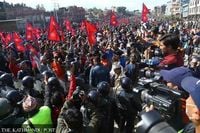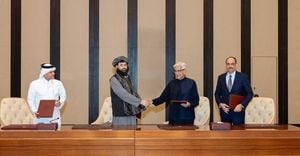The streets of Kathmandu are once again bracing for unrest as Nepal’s government scrambles to contain a new wave of protests, this time spearheaded by pro-Hindu leader Durga Prasai. With memories of last September’s deadly agitation still fresh, the authorities have adopted a dual approach: ramping up security while extending an olive branch for dialogue. The stakes are high, with national elections scheduled for March 5, 2026, and a restive youth population—often labeled as Generation Z—demanding change not just in Nepal, but across much of the Global South.
According to The Kathmandu Post, the government’s invitation to Prasai for talks came immediately after a high-level security meeting chaired by Prime Minister Sushila Karki on Saturday, October 25, 2025. Prasai, who has repeatedly called for Nepal to be restored as a Hindu state, has announced plans for mass demonstrations set to begin Monday, October 27, following the Chhath festival. In interviews with various media outlets, he claims thousands will take to the streets and block major highways, signaling the potential for significant disruption.
Home Minister Om Prakash Aryal confirmed the government’s strategy, telling reporters, “We have already invited him [Prasai] for talks.” Aryal emphasized that the Kathmandu Chief District Officer had been instructed to initiate dialogue, and that higher-level officials would join if necessary. “We have kept the door for dialogue open. We will seek solutions through talks,” Aryal said, according to a press note from the prime minister’s secretariat.
But dialogue is only half the plan. The government is also tightening security, mindful of the violence that erupted during Prasai’s previous agitation in March, which left at least two people dead. The September 2025 unrest, also linked to Prasai’s movement, saw hundreds of inmates escape from prisons and more than a thousand weapons looted by mobs—a stark reminder of how quickly protests can spiral out of control. As a result, the Ministry of Home Affairs has urged all parties to express their demands peacefully and warned against any actions that could jeopardize the upcoming elections.
“Public property must not be damaged. Private property must not be harmed. There should be no violence. Protests must be non-violent,” Aryal stressed, urging all political actors to demonstrate maturity and uphold the rights of others. The ministry’s statement further appealed to all groups to contribute to communal harmony and avoid disrupting public and national security, especially as the country prepares for crucial elections.
The government’s concerns are not unfounded. Officials worry that Prasai’s agitation could be infiltrated by a mix of right-wing, pro-Hindu, pro-monarchy, and anti-Gen Z groups, potentially escalating tensions even further. Security chiefs from the Nepali Army, Nepal Police, Armed Police Force, and National Investigation Department attended the Saturday meeting, presenting their assessments and discussing strategies to manage any fallout from the planned protests.
Meanwhile, the youth-driven Gen Z movement continues to make its presence felt in Nepal and beyond. Just days before Prasai’s planned agitation, Kathmandu police detained 50 members of a group called Gen Z United for staging a demonstration without official permission. According to The Kathmandu Post, the group had been protesting for two days, and their representative, Madan Karki, claimed they had sought permission from local authorities but were denied. Police cited concerns about possible clashes with other Gen Z factions as the reason for the detentions.
The rise of Generation Z as a political force is not unique to Nepal. In a recent essay published on October 24, 2025, by Vijay Prashad for the Tricontinental: Institute for Social Research, the author analyzes the phenomenon of Gen Z uprisings across the Global South. Prashad traces the roots of these movements back to the 2019 social uprising in Santiago, Chile, where high school students born between 2001 and 2005 led mass protests against neoliberal austerity. Since then, similar youth-led mobilizations have erupted around the world—from the Delhi protests against gang rape in 2012, to the March for Our Lives campaign against gun violence in the U.S. in 2018, to the Fridays for Future climate movement initiated by Greta Thunberg.
Prashad’s essay outlines seven theses to explain the Gen Z protests. First, he points to the youth bulge in the Global South, where the median age is just 25—and even lower in countries like Niger (15.3) and across Africa (19). Second, he highlights rampant youth unemployment, exacerbated by neoliberal policies that have weakened state capacity. Despite being the most educated generation in history, many Gen Zers face structural unemployment and precarious jobs, leading to what Prashad calls a “contradiction between aspiration and precarity.”
The third thesis centers on resistance to economic migration. In Nepal, for instance, young protesters have chanted, “We want jobs in Nepal. We don’t want to have to migrate for work.” The global scale of labor migration is staggering: nearly 168 million migrant workers send remittances back home, often sustaining entire economies but at the cost of social dislocation and personal sacrifice.
Fourth, Prashad notes the impact of large agribusinesses and mining companies on smallholder farmers, driving rural youth to cities and, eventually, into protest movements. Fifth, he emphasizes that for Gen Z, climate change is not some distant threat but a pressing reality—one that directly affects their ability to build a future. Melting glaciers, droughts, and floods are not just environmental issues; they are triggers for economic and social upheaval.
The sixth thesis addresses the failure of establishment politics to respond to youth grievances. Political parties, hamstrung by debt-austerity consensus and bureaucratic inertia, have left a vacuum that is increasingly filled by social media influencers and non-traditional actors. Finally, Prashad points to the rise of informal work and the gig economy, which has eroded traditional forms of worker solidarity and made social media the primary arena for political communication.
Yet, as Prashad cautions, these uprisings are largely urban and have struggled to engage rural populations or address the long-term structural crises facing underdeveloped countries. There is also the risk that entrenched interests—sometimes aligned with Western financiers—will co-opt these movements, channeling youthful energy into agendas that do not serve the majority.
Back in Kathmandu, these global dynamics are playing out in real time. The government’s balancing act—seeking to engage with Prasai while maintaining order and addressing the demands of Gen Z activists—reflects the complex, often fraught, relationship between youth movements and the political establishment. As Home Minister Aryal put it, “Now, everyone needs to engage in dialogue. Even those who take to the streets, in fact, want dialogue.”
With the countdown to national elections underway and Nepal’s streets once again a stage for competing visions of the country’s future, the challenge is clear: to channel the frustrations and aspirations of a new generation into constructive, peaceful change. If recent history is any guide, the coming months will test the government’s resolve—and the resilience of Nepalese democracy itself.





